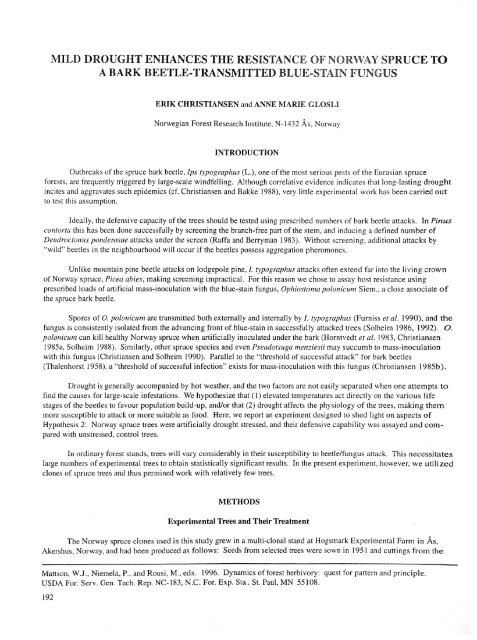View or print this publication - Northern Research Station - USDA ...
View or print this publication - Northern Research Station - USDA ...
View or print this publication - Northern Research Station - USDA ...
You also want an ePaper? Increase the reach of your titles
YUMPU automatically turns print PDFs into web optimized ePapers that Google loves.
MILD DROUGHT ENHANCES THE RESISTANCE OF N©RWAY SPRUCE TO<br />
A BARK BEETLE-TRANSMITTED BLUE-STAIN FUNGUS<br />
ERIK CHRISTIANSEN and ANNIE MARIE GLOSLI<br />
N<strong>or</strong>wegian F<strong>or</strong>est <strong>Research</strong> Institute, N-1432 A.s, N<strong>or</strong>way<br />
INTRODUCTION<br />
Outbreaks of the spruce bark beetle, Ips typographus (L.), one of the most serious pests of the Eurasian spruce<br />
f<strong>or</strong>ests, are frequently triggered by large-scale windfelling. Although c<strong>or</strong>relative evidence indicates that long-lasting drought<br />
incites and aggravates such epidemics (cf. Christiansen and Bakke 1988), very little experimental w<strong>or</strong>k has been carried out<br />
to test <strong>this</strong> assumption.<br />
Ideally, the defensive capacity of the trees should be tested using prescribed numbers of bark beetle attacks. In Pinus<br />
cont<strong>or</strong>ta <strong>this</strong> has been done successfully by screening the branch-free part of the stem, and inducing a defined number of<br />
Dendroctonus ponderosae attacks under the screen (Raffa and Berryman 1983). Without screening, additional attacks by<br />
"wild" beetles in the neighbourhood will occur if the beetles possess aggregation pheromones.<br />
Unlike mountain pine beetle attacks on lodgepole pine, I. typographus attacks often extend far into the living crown<br />
of N<strong>or</strong>way spruce, Picea abies, making screening impractical. F<strong>or</strong> <strong>this</strong> reason we chose to assay host resistance using<br />
prescribed loads of artificial mass-inoculation with the blue-stain fungus, Ophiostoma polonicum Siem., a close associate of<br />
the spruce bark beetle.<br />
Sp<strong>or</strong>es of O. polonicum are transmitted both externally and internally by L typographus (Furniss et al. 1990), and the<br />
fungus is consistently isolated from the advancing front of blue-stain in successfully attacked trees (Solheim 1986, 11992). O.<br />
polonicum can kill healthy N<strong>or</strong>way spruce when artificially inoculated under the bark (H<strong>or</strong>ntvedt et al. 1983, Christiansen<br />
1985a, Solheim 1988). Similarly, other spruce species and even Pseudotsuga menziesii may succumb to mass-inoculation<br />
with <strong>this</strong> fungus (Christiansen and Solheim 1990). Parallel to the "threshold of successful attack" f<strong>or</strong> bark beetles<br />
(Thalenh<strong>or</strong>st 1958), a "threshold of successful infection" exists f<strong>or</strong> mass-inoculation with <strong>this</strong> fungus (Christiansen 1985b).<br />
Drought is generally accompanied by hot weather, and the two fact<strong>or</strong>s are not easily separated when one attempts to<br />
find the causes f<strong>or</strong> large-scale infestations. We hypothesize that (1) elevated temperatures act directly on the various life<br />
stages of the beetles to favour population build-up, and/<strong>or</strong> that (2) drought affects the physiology of the trees, making them<br />
m<strong>or</strong>e susceptible to attack <strong>or</strong> m<strong>or</strong>e suitable as food. Here, we rep<strong>or</strong>t an experiment designed to shed light on aspects of<br />
Hypothesis 2: N<strong>or</strong>way spruce trees were artificially drought stressed, and their defensive capability was assayed and compared<br />
with unstressed, control trees.<br />
In <strong>or</strong>dinary f<strong>or</strong>est stands, trees will vary considerably in their susceptibility to beetle/fungus attack. This necessitates<br />
large numbers of experimental trees to obtain statistically significant results. In the present experiment, however, we utilized<br />
clones of spruce trees and thus permined w<strong>or</strong>k with relatively few trees.<br />
METHODS<br />
Experimental Trees and Their Treatment<br />
The N<strong>or</strong>way spruce clones used in <strong>this</strong> study grew in a multi-clonal stand at Hogsmark Experimental Farm in ,As,<br />
Akershus, N<strong>or</strong>way, and had been produced as follows: Seeds from selected trees were sown in 1951 and cuttings from the<br />
Mattson, W.J., Nieme1_i, P., and Rousi, M., eds. 1996. Dynamics of f<strong>or</strong>est herbiv<strong>or</strong>y: quest f<strong>or</strong> pattern and principle.<br />
<strong>USDA</strong> F<strong>or</strong>. Serv. Gen. Tech. Rep. NC-183, N.C. F<strong>or</strong>. Exp. Sta., St:.Paul, MN 55108.<br />
192
















